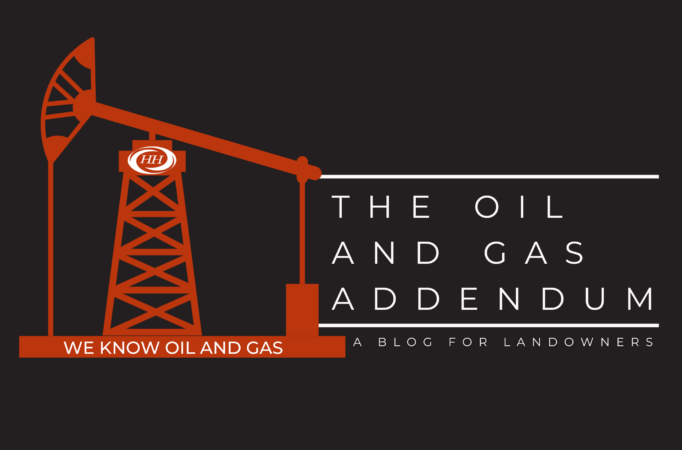The Oil and Gas Addendum
Driller Has No Obligation to Pay Royalty on Lost Gas
Imagine you own an apple orchard. You sign a contract with XYZ Produce which grants them the exclusive right to harvest your apples. At the end of the season, XYZ Produce comes out and harvests the orchard. As per your contract, the harvested apples are counted by XYZ Produce before they are shipped off site. There are 342 bushels. Two weeks later you get your royalty statement and it says that only 334 bushels were actually sold at market. Your contract with XYZ Produce requires them to “credit” you for the lost, damaged or unaccounted for apples that never make it to market. Unfortunately, the same is not true with respect to your oil and gas lease. As noted in a recent Pennsylvania Superior Court decision, a driller generally has no obligation to reimburse or credit you for your gas that does not make it to the eventual point-of-sale.
It is not uncommon for gas volumes to decline between the wellhead and the down-stream point-of-sale. There are three reasons for this discrepancy. First, there can be a reduction in the volume of gas due to simple evaporation or leakage as it flows downstream. This is sometimes referred to “line loss”. Second, drillers often use the natural gas from the well to fuel and operate compression facilities and other well-pad equipment. This category is commonly referred to as “used gas”. Collectively, these two components of lost gas are known as “unaccounted” gas. Finally, drillers sometimes “flare” or burn off natural gas at the wellhead. This is done to determine the pressure, flow and composition of the gas from the well. Unlike the apple farmer, unless the parties’ lease states otherwise, the landowner is generally not entitled to be paid any royalty or credit on the “unaccounted” or flared gas. As commodity prices continue to remain stagnant, landowners are growing increasingly frustrated with this practice. Does the landowner have any remedy?
As with most oil/gas questions, the answer is dependent on the precise language in the parties’ lease. Many oil/gas leases here in the Appalachian Basin provide that the landowner’s production royalty is based on a percentage of the price received by the lessee. These are generally known as “proceeds” royalties. The payment-measuring point for these types of leases is the amount of gas sold, not the amount delivered at the wellhead. See, Dynegy Midstream Services v. Apache Corp., 294 S.W. 3d 164, 174 (Tex 2009) (“[A] percentage of proceeds contract measures payment solely as a percentage of proceeds from actual sales . . .”) In other words, the royalty calculation is tied to the price and proceeds actually received by the lessee. A minority of leases contain “market-value” clauses. A market-value lease calculates the royalty on the volume of gas produced and metered at the wellhead. The royalty clause in such a lease will typically state that the lessor is entitled to “eighteen percent of the market value of the gas produced and measured at the wellhead . . .” The distinction can be critical when it comes to mitigating the effect of unaccounted and flared gas.
In a market-value lease, a royalty is generally paid on all gas, including the unaccounted and flared gas. This is because the critical royalty metric is the actual volume of gas produced at the wellhead. Gas that is lost or used downstream from the wellhead must still be factored into the royalty calculation. Conversely, a “proceeds royalty” is dependent upon actual sales. The gas must be sold in order to generate a royalty. Gas that is unaccounted for or flared is not “sold” and therefore no royalty is due and owing. See, Chesapeake Exploration v. Hyder, 427 S.W.3d 472 (Tex-San Antonio 2014) (noting that the driller’s obligation to tender royalty is not “triggered” until the gas is sold); Tano Oil and Gas Corp v. Cernosek, 188 S.W.3d 354 (Tex- Austin 2006) (“[T]ano is only obligated under the lease agreement to pay the Class royalties on money actually received; Tano is not required to pay royalties on the value of gas that was never sold downstream”). Likewise, gas that is used to power compressor facilities or other equipment at the well-pad is not sold, so no royalty is owed. As such, it is difficult for a landowner with a “proceeds royalty” clause to contest or challenge this practice.
The difficulty of such a challenge is illustrated by the recent Pennsylvania Superior Court case of Hall v. CNX Gas Company, No. 1703 WDA 2014 (April 7, 2016). In Hall, the landowner brought an action against CNX Gas in Allegheny County asserting that the driller breached the parties’ 1998 oil/gas lease by allocating and combining their “share” of lost and unaccounted gas with other leaseholds. The Halls contended that since CNX Gas did not measure the volume of the gas from their well prior to comingling with others, CNX Gas could not attribute the precise amount of lost or unaccounted gas from that well. Instead, CNX Gas simply totaled all of the lost gas from the unit wells and allocated a percentage to each landowner. Since the parties’ lease did not expressly authorize or permit the allocation of lost gas, the Halls argued that CNX Gas had breached their lease and that they should be reimbursed for this artificial allocation of lost gas.
In rejecting the Halls’ claim, the Superior Court noted that lost and unaccounted gas is simply not part of the royalty calculation. The court observed that “the language providing for royalties to be calculated on the net amount realized at the point-of-sale obviates the need for a term allocating lost and used gas.” Since the parties’ lease contained a “proceeds royalty” clause, the 1/8th royalty was calculated only on the gas that was actually sold. The court observed that at the actual point-of-sale, there is no lost gas:
“…at that point, the lost and used gas was not in existence. In short, royalties were not due on lost or used gas as it did not reach the point-of-sale.”
Hall, p. 11. As CNX Gas had no obligation to pay any royalty on the lost or unaccounted gas, the Superior Court concluded that the fact that the parties’ lease was silent on the issue of allocating such amounts was immaterial.
For landowners with a “proceeds royalty” clause, the Hall case is not good news. Hall re-affirms the long-standing principle that a “proceeds royalty” is based on actual sales. Unless the gas is sold, no royalty obligation accrues. When negotiating a new lease, landowners should endeavor to draft a market-value or volume-based royalty clause, if possible. These clauses mitigate the effect of lost or unaccounted gas since the royalty calculation is based on the volume of gas and not the sale proceeds. Unfortunately, most drillers in the Appalachian Basin are resistant to such clauses and insist on a “proceeds royalty”. In the absence of a volume-based royalty, landowners should try to negotiate specific limitations and restrictions on flaring or fuel usage. These clauses can reduce the amount of lost gas and maximize royalty efficiency.
About Us
Oil and gas development can present unique and complex issues that can be intimidating and challenging. At Houston Harbaugh, P.C., our oil and gas practice is dedicated to protecting the interests of landowners and royalty owners. From new lease negotiations to title disputes to royalty litigation, we can help. Whether you have two acres in Washington County or 5,000 acres in Lycoming County, our dedication and commitment remains the same.
We Represent Landowners in All Aspects of Oil and Gas Law
The oil and gas attorneys at Houston Harbaugh have broad experience in a wide array of oil and gas matters, and they have made it their mission to protect and preserve the landowner’s interests in matters that include:
- New lease negotiations
- Pipeline right-of-way negotiations
- Surface access agreements
- Royalty audits
- Tax and estate planning
- Lease expiration claims
- Curative title litigation
- Water contamination claims

Robert Burnett - Practice Chair
Robert’s practice is exclusively devoted to the representation of landowners and royalty owners in oil and gas matters. Robert is the Chair of the Houston Harbaugh’s Oil & Gas Practice Group and represents landowners and royalty owners in a wide array of oil and gas matters throughout the Commonwealth of Pennsylvania. Robert assists landowners and royalty owners in the negotiation of new oil and gas leases as well as modifications to existing leases. Robert also negotiates surface use agreements and pipeline right-of-way agreements on behalf of landowners. Robert also advises and counsels clients on complex lease development and expiration issues, including the impact and effect of delay rental and shut-in clauses, as well as the implied covenants to develop and market oil and gas. Robert also represents landowners and royalty owners in disputes arising out of the calculation of production royalties and the deduction of post-production costs. Robert also assists landowners with oil and gas title issues and develops strategies to resolve and cure such title deficiencies. Robert also advises clients on the interplay between oil and gas leases and solar leases and assists clients throughout Pennsylvania in negotiating solar leases.

Brendan A. O'Donnell
Brendan O’Donnell is a highly qualified and experienced attorney in the Oil and Gas Law practice. He also practices in our Environmental and Energy Practice. Brendan represents landowners and royalty owners in a wide variety of matters, including litigation and trial work, and in the preparation and negotiation of:
- Leases
- Pipeline right of way agreements
- Surface use agreements
- Oil, gas and mineral conveyances

